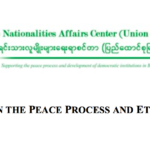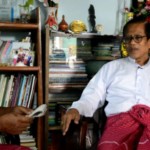By Sai Wansai / Shan Herald Agency for News (SHAN) | August 14, 2017
Again, the official sixth meeting between the United Nationalities Federal Council’s (UNFC) Delegation for Political Dialogue (DPN) and the government’s Peace Commission (PC) held from August 10 to 11, wasn’t able to produce an all encompassing agreement for the former to sign the Nationwide Ceasefire Agreement (NCA). But accordingly four from the eight-point UNFC’s proposal to be added to the NCA were tentatively agreed with the rest four points to be still discussed and agreed upon at the forthcoming seventh official meeting that should take place in September.
Reportedly, the four agreed points were said to be from 1 to 4 and the points from 5 to 8 would be thrashed out in the upcoming September official seventh meeting after the Ethnic Armed Organizations (EAOs) and government have consulted their respective leadership in details.
Although there has been a little confusion as to whether the UNFC amendment proposal to the NCA is 8 or 9 points, the reality is just 8, as the point number 9 merely said that “As soon as the above said points are in agreement, the NCA would be signed.”
To refresh our memories let us again look at the said 8-point UNFC amendment proposal. They are:
- Bilateral ceasefire agreement between the government-military and the UNFC;
- To build a federal union with result achieved from 21st Century Panglong Conference (21CPC);
- Agreement of tripartite dialogue composition;
- Drafting and promulgation of constitutional law based on the outcome of 21CPC;
- Advance agreement on Military Codes of Conduct (CoC) and monitoring on Terms of Reference (ToR);
- Formation of military Joint Monitoring Committee (JMC) with representatives from government, EAOs and international figures acceptable to both parties;
- Formation of a neutral, enforcement tribunal for NCA involving domestic and international law experts and judges that are acceptable to both parties; and
- Developmental projects to be tackled according to Extractive Industries Transparency Initiative (EITI), in cooperation with the public and the EAOs. (Source: UNFC Documentation)
Naturally, hopes were high for the government and as well the UNFC negotiators as half of the UNFC proposal could be agreed upon and that the enthusiastic optimism, especially from the government’s side, that the other half would be easily overcome at the next meeting in September, should be taken with a pinch of salt.
Khu Oo Reh, head of the DPN at the end of the meeting said: “I could say that we are getting extremely near to participate equally and seriously together in our works. As we are not in a position to decide all things on our own, we would like to request the citizens to have understanding on this.”
He probably meant to say that that the DPN has to consult with its leadership and also, the cooperation of the Tatmadaw is needed to implement the agreed points.
He went on to explain the nature of the peace process has to go step-by-step and that they are hoping to achieve peace as soon as possible through mutual cooperation by all stakeholders.
Earlier on the eve of the sixth official meeting, Khu Oo Reh, regarding the UNFC’s proposal that if some of the points are not in agreement, it should be construed as there is no agreement, stressed: “We heard what the media are reporting. Some said there are two, three or one point left (to agree). No matter how points are left to be discussed, even if one is left it is like all the eight points are not in agreement.”
It seems Khu Oo Reh has taken a leaf out of the Geneva Accords of 24 November 2013 between Iran and 5+1 Powers regarding the nuclear case of Iran, where the reference to the phrase “Nothing is agreed until everything is agreed”, was made at the beginning and the end of the document and since then becoming a standard usage in all earnest treaty deliberations.
Tun Zaw, secretary of Arakan National Council (ANC) and member of the UNFC’s DPN also echoed the same sentiment regarding the four points agreement of the UNFC’s proposal, he said: “Only if all eight points are thrashed out we could reach the stage of signing (the NCA) and still need to try and labor more on it,” according to the interview by Mon News Agency of August 12.
He also make a point that the Tatmadaw or the Military has no interest, “political will” and advancing the closely connected “trust-building” whatsoever. He further said that the National League for Democracy (NLD) regime is enthusiastic and has full commitment for political settlement but the Tatmadaw is still clinging to the old institutional mechanism that it has represented for decades.
The government spokesperson Zaw Htay just merely confirmed the meeting’s progress saying: “Half of the points were generally agreed upon as a result of the sixth round of talks. Discussion concerning the other half must be presented to the leaders of both sides for a final decision.”
Chair of the government’s National Reconciliation and Peace Center Tin Myo Win said he, “hope
“If we can pass this point, the peace process will not stop or move backwards. It will keep going forward, toward peace,” he added.
Outlook and Perspective
Regardless of the prevailing optimistic view that the remaining four points of UNFC proposal could be thrashed out leading to the signing of the NCA, lack of political will and trust-building from the part of the Tatmadaw might hinder real progress on the ground, as Tun Zaw has correctly pointed out.
With this in mind, let us look at the issues tied to the UNFC’s NCA amendment proposal of bilateral ceasefire; establishment of a federal union; tripartite composition; constitutional amendment; international involvement in JMC; formation of a neutral, mediation and enforcement tribunal for dispute arising from NCA implementation; and resources management.
Bilateral ceasefire is, in fact, not just between the Tatmadaw and the UNFC, as the former meant to say that ceasefire with only the NCA signatory EAOs, while the latter understood it to be nationwide declaration of ceasefire, implying that every corner of the country must be covered by the ceasefire agreement.
Concerning the establishment of a federal union with the result or outcomes from 21CPC, the Tatmadaw notion of federalism is tied to its self-drawn 2008 constitution which is neither federal nor democratic.
The tripartite composition participation mode at all level of political negotiations, so far as the UNFC is concerned, would be: government, Tatmadaw, parliament; EAOs; and political parties. The previous participation in Union Peace Conference (UPC) – now renamed Union Peace Conference – 21st Century Panglon (UPC-21CP) – were counted seven parties with 700 participants. It is still not clear if the Tatmadaw and the government have agreed to the UNFC’s mode of composition.
Constitutional amendment, actually rewriting anew by making use of the outcomes from 21CPC, would be accepted by the Tatmadaw is unclear, as it always maintain that it would protect the military-drafted 2008 constitution, which is in no way a federalism, with all its might.
The CoC, ToR and troops relocation still could not be completed and some already formed state-level JMC were unable to stop the ceasefire breakdown happening very often between the NCA signatory Restoration Council of Shan State/Shan State Army (RCSS/SSA) and the Tatmadaw.
International involvement in the JMC and NCA mediation-enforcement roles have always been rejected by the Tatmadaw, arguing that it is a problem between brethren and outsiders should not be involved, and is highly unlikely this proposal could sail through easily, even though a clause in the NCA doesn’t rule out such an arrangement.
Indeed, in the NCA a paragraph 12(c), signed between the 8 EAOs and the government on 15 October 2015, said: “We shall jointly decide on the basis of mutual agreement, the role of representatives from foreign governments and international organizations that are involved in the ongoing peace process, either as observers, advisors or to provide necessary technical assistance at different levels of the Joint Ceasefire Monitoring Committee.”
As for the resources management, including international humanitarian aids to be administered in cooperation between the concerned EAOs of the area and the government, with the consent of the people could be easily ironed out, if all the other proposal points could be worked out.
To sum up, the above mentioned points have to be adjusted and agreed upon if the UNFC is to sign the NCA and eventually participate in the next upcoming 21CPC. It won’t do just to repeatedly push for the UNFC to sign the NCA without accommodating its proposal.
Thus, it would do all parties good if there could be a compromise on the UNFC proposal in the upcoming seventh official meeting, as this would demonstrate a desire to be equal and stimulate trust-building that has been in deficit all along. This, in turn, could even encourage the Panghsang alliance or Federal Political Negotiation and Consultative Committee (FPNCC) to rethink its policy of only to meet the government as a group and not separately.
At the end of the day, it will all depend on if the NLD and the Tatmadaw would be able to communicate on the same wavelength, especially where all-inclusiveness, national reconciliation, achieving and instilling peace for the benefit of the people and country are concerned.
This article originally appeared on SHAN on August 14, 2017.






